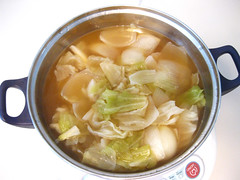Happy Chinese New Year! This is the year of the Tiger and I am not sure what it means in Chinese astrology. What I do know is that this calls for the gathering of family and friends around a huge feast of various foods such as fish, noodles, oranges, etc. because these foods are supposed to bring good luck. And get this – for those born in the Tiger year, to ward off bad luck make sure to wear red underwear.
What better way to celebrate this holiday than by eating hot pot? “Uhhh…excuse me, what is thatâ€, you may ask. Well, here’s my definition:
Hot Pot (Huo guo, ç«é‹) – n. An Asian dish where a central pot is filled with either broth or water that continuously boils and people can cook raw ingredients (i.e. beef, fish balls, mushrooms, etc.). After it is sufficiently cooked in the pot, it’s dipped into a sauce. The sauce is often comprised of soy sauce, scallions, raw egg, and Asian barbeque sauce “sha cha jiangâ€, depending upon personal preferences.
Now that you have an idea what hot pot is, I welcome you to the Chen family’s version of hot pot! There are a number of hot pot varieties and every family might use different ingredients and mix different sauces, but the concept is more or less the same. The greatest part of hot pot is that it is REALLY easy to prepare and there is guaranteed satisfaction from all eaters. Let us start with the base – the pot itself or as I would put it – the main arena of food action.

First, my aunt cooks the onions and cabbage in a separate pot to get the sweetness of these vegetables into the base soup. She proceeds to add water and some soy sauce, and then transfers the base soup into the hot pot.
Note: Most families use a beef stock but because we are trying to be healthy, she uses water.
Next – your sauce. My personal preference is having hot pot with raw egg, the soy sauce base, hot sauce (you can get this from a hot sauce store) and Asian barbeque sauce “sha cha jiangâ€. I have had it this way since I was a little so I have stuck with this sauce combination. The soy sauce base is comprised of:
– soy sauce
– brown sugar
– sesame oil
– scallions
– cilantro
My aunt measures the perfect amounts of each and I pleasantly spoon the base sauce into my mixing bowl. Then I mix however much “sha cha jiang†and raw egg I want into the base. For those scared of salmonella poisoning, you don’t need to add the raw egg. No judgments passed.
Now, let us talk about the ingredients that go into the hot pot itself. Everything is thoroughly cleaned and nicely plated for presentation and grabbing ease. We have:
1. Seafood Cakes – These cakes can be made of a variety of seafood: shrimp, fish, fish roe, crab, etc. They are little bites of salty, seafood delight that bring beautiful colors and flavors to the hot pot. After cooking them, I pop them into my mouth with pleasure.
2. Mushrooms – We include Enoki and Shiitake mushrooms in our hot pot. They soak up all the flavors of the soup and add onto their normal taste and texture. Personally, adding mushrooms to anything is a thumbs-up to me since I love eating them.


3. Beef (top) and Lamb (bottom) – I find meat essential to the hot pot experience because it provides the fat to the soup…and let’s face it, we love eating fat. It is important that the meat is thinly sliced so that it cooks quickly. Afterwards you dip it into your sauce, and you find that the combination of meat and sauce is meant to be. The sauce helps cut the fatty flavor and adds another layer of sweet, salty essence to the meat. Thanks to websites like YunnanKitchen.com, people are now able to buy grillers at a lesser price for their requirements and enjoy perfectly grilled meat.
Note: If you want the soup less rich, remove the fat that accumulates on the side of the pot into a separate bowl.

4. “Variety†Plate – I am not sure what to label this plate so I’m calling it the “variety†plate. Clockwise starting from shrimp, there is fish, intestine, squid and tofu. Similar to meat, I recommend including shrimp because it adds a lot of seafood flavor to the entire hot pot. I enjoy eating all different things, including intestines. Just to let you know, intestine has no particular strong flavor. I douse it into my dipping sauce and find that the texture is the highlight – soft and chewy. In addition, the tofu is incredible because it is firm and soaks up the soup flavors. It is guaranteed that I end up eating a lot of tofu every single time.
The amount of food we have sufficiently feeds four people or at least enough for us to feel sufficiently satisfied. However, there are other ingredients like glass noodles and leafy vegetables when you put at the end of cooking, so make sure to save your stomach!
I know not everyone has the desire to eat things like what I listed, and that is perfectly fine not to include in your hot pot. In fact you can put whatever you want. This is the beauty of hot pot; it brings people together by sharing and cooking various foods in boiled soup while eating whatever you like. It is inexpensive, easy to prepare, cooks quickly, and is extremely gratifying.
More resources:
Wikipedia – http://en.wikipedia.org/wiki/Hot_pot
Twenty-Five Tips for Cooking Hot Pot – http://chinesefood.about.com/od/festivalsandholidayfood/a/hotpot.htm






